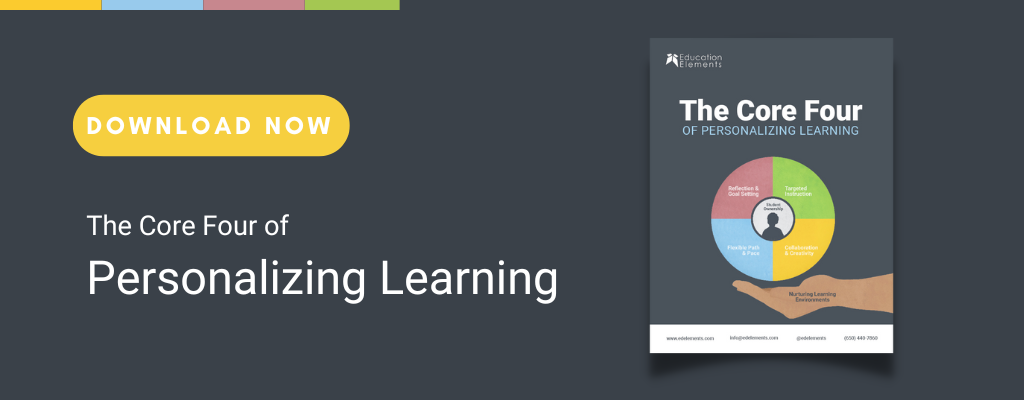Prior to becoming a consultant for Education Elements, I served as a Middle School Math Teacher. It was a tough but rewarding job, and I absolutely loved it. Math is a passion of mine, and I adore the raw, sarcastic, hilarious moments that often come from interacting with middle school students.
Decision-makers in the classroom
In reflecting on my time as a teacher, there is something that stands out: how decisions were made (and by whom) in my classroom. For example, take a look at the following two lists:
Things that were decided for my students:
- What to wear
- When to arrive at school
- What to eat for breakfast and lunch
- Class schedule
- Seating assignment
- Lesson/content for the day
- Assignments to complete and when to complete them
- Classroom management/discipline decisions
Things that were decided by my students:
If you are wondering if that was a typo, it wasn’t. The more I work with districts on implementing Personalized Learning at their schools, the more I realize how little ownership my students had in my classroom. I heard the term “Personalized Learning” float around at my district professional development sessions and read about it in blogs, but I didn’t fully understand what it meant or how it could serve my students. I didn’t realize that personalizing learning for my students was something I could take on as an individual classroom teacher, even if other teachers within my district weren’t and even if it wasn’t a district-wide initiative. Now that I work at Education Elements, here are three things I wish I knew about Personalized Learning and the impact it could have had on my students.
Student ownership does not minimize the impact of the teacher.
As a teacher, when I thought about transferring ownership to students, I used to wonder, “If they are running the classroom, what is my job?” Though a student-driven classroom look like students own the work involving their learning, it does not mean that the work of the teacher is not important. When thinking about the Core Four of Personalized Learning, there is a lot of prep work that goes into creating an environment that is conducive to student ownership. A large part of students’ finding success with Personalized Learning is the work the teacher does behind the scenes. From incorporating data to create intentional groupings, creating stations that match student needs and interests, and supporting students in purposeful goal setting aligned to learning trajectories, teachers are engaged in enabling student success. (Stay tuned for upcoming blogs about using data to drive PL forward in the classroom) As an educator, there is so much that you are in charge of on a day-to-day basis and those to-do’s often come with little recognition. But here I am saying thank you in advance for choosing to let students drive their own learning and get exactly what they need to be successful in the classroom and beyond.
Personalized Learning is a framework, not a curriculum.
Something that used to intimidate me about Personalized Learning was that I believed it was a whole new curriculum to implement alongside the one mandated by my district. I already had resources and lesson plans aligned to this district curriculum, and to stay on track with pacing, there was no way I could add more material to teach. But something that one of my clients recently shared about Personalized Learning that hit home for me is that “Personalized Learning is just good teaching.” She talks about how when we embed PL practices in our classrooms, our students become drivers of their work and magic happens. You do not need a certain curriculum to do this work, nor do you have to spend hundreds of dollars on teaching resources, you simply need to be invested in giving your students opportunities to drive their learning and be willing to make a few small changes to get there.

Small changes can lead to a big impact.
Making changes in our work is hard. We are often able to recognize that doing things differently would be better for ourselves and our students, but the work necessary to make that change happen can be daunting. We often don’t have the time, resources, or energy to make that shift. What I wish I realized earlier is that we don’t have to do a full 180-degree turn overnight. Turning our classrooms into model Personalized Learning classrooms takes time, a lot of it. One concept we use with our clients at Education Elements is the 1% shift. When we continuously make small changes in our practice, we will start to see a big transformation. My students would not have been able to go from never setting their own goals to looking at a data source and choosing the small group station that best fit their needs overnight. Instead, a 1% shift I could have implemented was conferencing with students about their growth based on exit ticket data and helping them set a goal to improve the next day. What is a 1% shift you can make today to begin the work of personalizing learning for your students?
While I can’t go back and redo my time as a teacher for those same students, in my new role I get to help teachers design the classroom that I wish I had created. I get to engage in learning walks through some incredible schools and see how all of the 1% shifts are adding up to make huge strides in driving classrooms to become more student-driven. I support teachers in thinking of their next steps to help them move forward, leading to transformative impacts on student performance and engagement in the classroom.